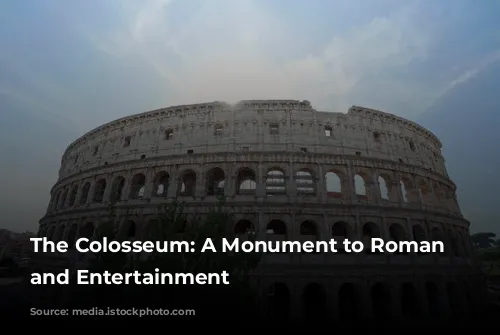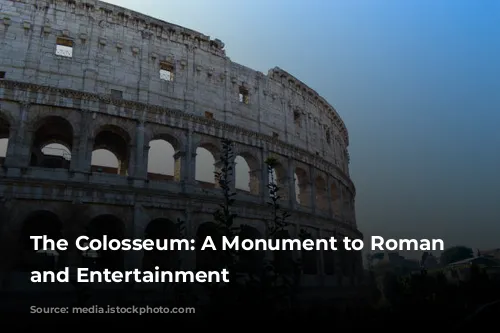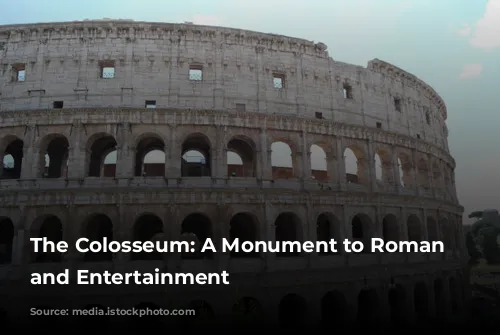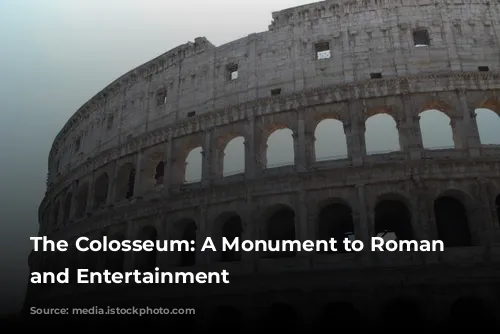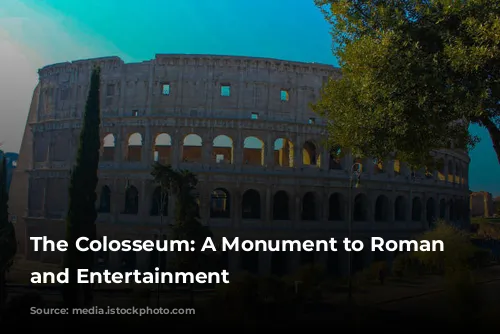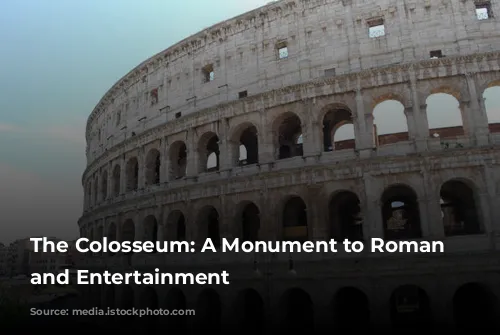The Flavian Amphitheatre, more commonly known as the Colosseum, is an iconic landmark in Rome and a symbol of the Roman Empire’s power and grandeur. This massive amphitheatre, the largest ever built in the Roman world, was commissioned by Emperor Vespasian and inaugurated by his son, Titus, in 80 AD.
The Colosseum’s opening ceremony was a spectacle of extravagance, lasting one hundred days and featuring gladiatorial combats, animal hunts, and even mock sea battles called “naumachiae” in a flooded arena. These events showcased the Empire’s wealth and dominance, captivating the Roman public with their scale and brutality.
The Name and Structure of the Colosseum
But why is it called the Colosseum? This name emerged in a prophecy by the Venerable Bede, a medieval monk, who claimed that Rome would stand as long as the Colosseum did. He may have taken the name from the “Colossus,” a massive statue of Emperor Nero that once stood near the amphitheatre.
The Colosseum’s imposing structure is a testament to Roman architectural prowess. Constructed with travertine stone, it features a distinctive elliptical shape, maximizing spectator capacity. Four tiers, each with 80 arches, adorned with statues and intricate details, rise from the ground. This colossal structure, which holds up to 70,000 spectators, was built in less than ten years, a remarkable feat for its time.
Roman Architectural Ingenuity: The Arch
The Romans’ mastery of the arch was a key factor in the Colosseum’s construction. Arches allowed them to distribute the weight of massive structures efficiently and effectively, a technique they utilized in other monumental projects like aqueducts. In essence, the Colosseum can be seen as a series of arches stacked upon each other.
The Colosseum: From Arena to Quarry
The Colosseum we see today is a skeleton of its former glory, with three-fifths of its outer brick wall missing. Throughout history, the Colosseum was plundered for materials, its marble, lead, and iron used to construct other buildings in Rome, including the Barberini Palace, Piazza Venezia, and even St. Peter’s Basilica.
The holes visible in the Colosseum’s columns are remnants of this plundering, evidence of the extraction of lead and iron used in the original construction.
Spectator Experience: A Social Hierarchy
The Colosseum offered a glimpse into Roman society’s social hierarchy. Entry was free for all Roman citizens, but seating was assigned according to social status. The highest tiers were reserved for the common people, while senators, priests, and the emperor occupied the front rows. Even within these sections, men and women were separated, reflecting the strict social norms of the time.
The Colosseum also provided a sophisticated system of protection from the sun. A giant awning called the “Velarium”, made of linen and controlled by a system of ropes, winches, and poles, could be lowered to shade the arena. This impressive feat of engineering required the coordination of one hundred sailors from the Imperial fleet, who moved the Velarium in perfect synchronization.
The Arena: A Stage for Spectacle
The Colosseum’s arena was a stage for a variety of spectacles, ranging from the thrilling to the brutal. “Venationes” – hunts featuring exotic animals and often culminating in the death of both animals and humans – were a popular morning event. “Silvae,” elaborate set pieces simulating forests, provided a more theatrical and less violent form of entertainment.
One of the most memorable spectacles involved an elephant trained to write words in the sand. This event, along with the “venationes,” captivated the Roman populace, showcasing the Empire’s control over the natural world.
Gladiators: Heroes of the Arena
The gladiators were the stars of the Colosseum, their battles the heart of the spectacle. After a midday break, the arena was cleared of the previous day’s blood and sand, and the gladiators emerged from an underground passageway, greeted by the roaring crowd. These warriors, many of them prisoners of war or impoverished individuals, often fought for freedom and wealth, enjoying fame and even the affections of women.
The gladiators’ lives were often short and brutal. They battled with an assortment of weapons, from nets and tridents to shields and swords, engaging in dramatic and sometimes deadly combat. The fate of a wounded gladiator rested in the hands of the emperor, who could grant mercy or pronounce death, with the crowd’s cheers and jeers determining the outcome.
The Colosseum: A Symbol of Roman Civilization
The Colosseum was a microcosm of Roman civilization, a testament to their architectural ingenuity, social hierarchy, and fascination with spectacle and violence. Its grandeur and complexity, combined with the raw emotions it evoked, left a lasting impression on the Roman world and continue to captivate us today.
Today, the Colosseum stands as a reminder of the grandeur of ancient Rome, a monument to the power of the Empire and the allure of spectacle. While its violent history is undeniable, its legacy as a symbol of human ingenuity and the enduring fascination with entertainment continues to resonate across the ages.
